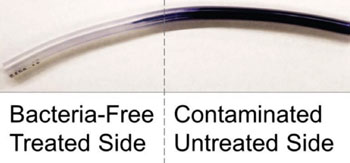Slippery Surface Technology Repels Bacterial Biofilm
By HospiMedica International staff writers
Posted on 05 Mar 2015
Novel lubricant-infused slippery polymers could serve as a long lasting, self-replenishing solution to repel deadly bacterial build-up in medical devices. Posted on 05 Mar 2015
Researchers at Harvard University (Cambridge, MA, USA) have developed new non-fouling medical materials that are based on oil-infused polydimethylsiloxane (iPDMS). The planar and tubular geometry silicone substrates can be infused with nontoxic silicone oil to create a stable, extremely slippery interface that exhibits exceptionally low bacterial adhesion and prevents biofilm formation. According to the researchers, the iPDMS materials can be applied as a coating on other polymers or prepared by simply immersing silicone tubing in silicone oil, and are compatible with traditional sterilization methods.

Image: Repellent surface technology prevents biofilm formation (Photo courtesy of Joanna Aizenberg/ Harvard).
The researchers also prepared silicone-coated polyurethane catheters and demonstrated a significant reduction of Escherichia coli and Staphylococcus epidermidis biofilm formation on the catheter surface. An analysis of a flow culture of Pseudomonas aeruginosa through untreated PDMS and iPDMS tubing showed at least an order of magnitude reduction of biofilm formation on the iPDMS, and almost complete absence of biofilm on iPDMS after a gentle water rinse. The study was published in the January 2015 inaugural issue of ACS Biomaterials Science and Engineering.
“There is a dire need for infection prevention strategies that do not require the use of antibiotics, which exacerbate the rise of multi- and pan-drug resistant infectious organisms. An important target in this area is the bacterial attachment and subsequent biofilm formation on medical devices,” said senior author, Professor of Chemistry and Chemical Biology Joanna Aizenberg, PhD. “Each technology in our portfolio has different properties and potential uses, but collectively this range of approaches to surface coatings can prevent a broad range of life-threatening problems, from ice accumulation on airplane wings to bacterial infections in the human body.”
“With widespread antibiotic resistance cropping up in many strains of infection-causing bacteria, developing out-of-the-box strategies to protect patients from bacterial biofilms has become a critical focus area for clinical researchers,” said Prof. Donald Ingber, PhD, director of the Harvard Wyss Institute for Biologically Inspired Engineering. “Liquid-infused polymers could be used to prevent biofilms from ever taking hold, potentially reducing rates of infection and therefore reducing dependence on antibiotic use.”
Liquid-infused polymers leverage the molecular structure of polymers, making them highly capable of absorbing and storing considerable volumes of lubricating liquids, like sponges. This allows for a large reservoir of lubricant, which can travel to the surface and render it continuously slippery and repellent, creating an environment that challenges the bacteria’s ability to colonize.
Related Links:
Harvard University














